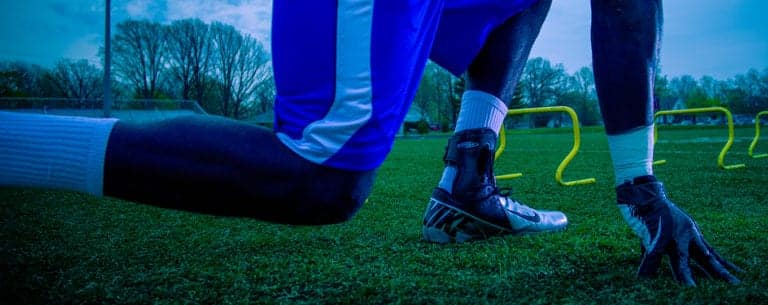
As a high impact sport, football players wear more protective gear than many other athletes. Players must protect themselves from injury by wearing the most advanced equipment from state-of-the art helmets, to breathable pads, all the way down to advanced ankle braces. Since the responsibility of each athlete varies greatly from position to position, some players are at a higher risk of ankle injuries and should be especially concerned with which ankle brace is best for football.
Football Positions that Should Wear an Ankle Brace
Unlike sports with a much higher ankle injury rate for every player, you’re not going to see the entire team wearing preventative ankle bracing in football – usually only the offensive and defensive linemen. The football players on the line are typically the most vulnerable for ankle injuries due to the fact that they quickly pivot and turn while other players are constantly falling on their legs/ankles.
Most of the ankle injuries suffered by linemen are high ankle sprains, which are more severe than a classic ankle sprain and can take twice as long to heal. Once an ankle sprain occurs, there is a 70% chance that the ankle will be re-sprained. With each ankle sprain the ankle ligaments become further and further stretched apart making the ankle joint more loose and unstable with each sprain.
Which Ankle Brace is Right for You?
For this reason, linemen have started to wear ankle braces to help prevent football ankle injuries or lessen the severity should an injury occur. For offensive/defensive linemen it’s not only crucial to keep their ankles healthy, but also to be able to get down in their stance comfortably while retaining their explosive power. To meet both of these expectations, the best ankle brace for this position would be a hinged brace with a flexible shell, such as the Ultra Zoom®, that custom fits to the ankle for maximum comfort and provides full range of motion.
Although linemen are the most susceptible to ankle injuries during play, many other players on the field may still be wearing an ankle brace – especially those with a history of ankle injuries or chronic ankle instability. In the case of chronic ankle instability, the athletes should wear an ankle brace that offers more long-lasting support than taping or a lace-up style support, such as the hinged-cuff Ultra High-5®, that can withstand the pounding of an entire football season while providing maximum protection to help prevent furthering injuring the joint.
Regardless of which position you may play, if you’re interested in learning more about if you should be wearing an ankle brace for football send us a message. Our certified athletic trainer would be happy to answer any of your questions and help you stay on the field all the way from two-a-days through the championship game.
SHARE WITH FRIENDS
RECENT POSTS
POST BY TOPIC
- Acute Ankle Injuries (5)
- Ankle Bracing (23)
- Ankle Injuries (13)
- Ankle Injury Prevention (15)
- Ankle Instability (6)
- Athletic Training (1)
- Basketball (9)
- Football (8)
- High Ankle Sprain (6)
- Hiking (4)
- injury (2)
- Mild/Moderate Ankle Injury (1)
- News (2)
- Osteoarthritis (3)
- Pickleball (7)
- Soccer (8)
- Sports (15)
- Tennis (8)
- Ultra 360 Lace-Up (3)
- Ultra CTS (8)
- Ultra High-5 (2)
- Ultra Zoom (14)
- Uncategorized (4)
- Volleyball (8)